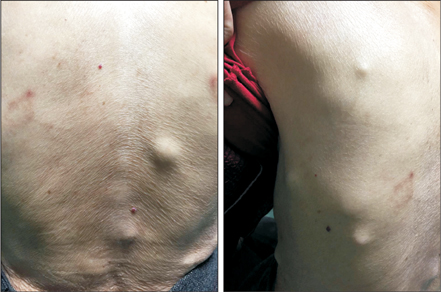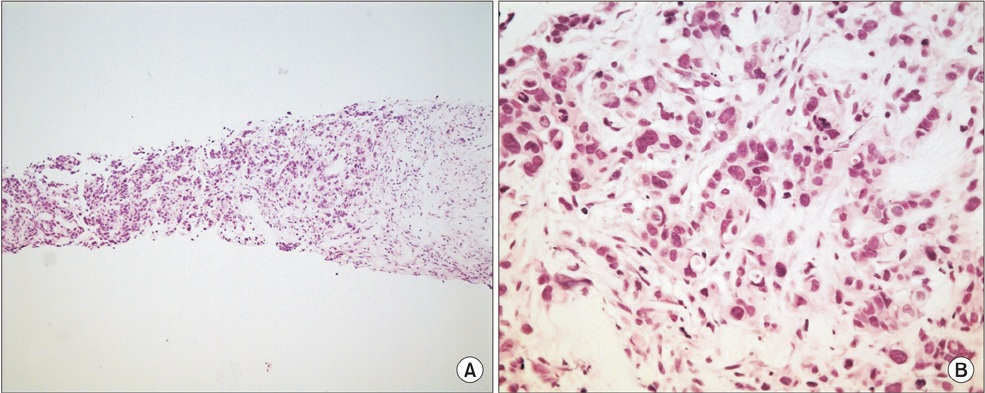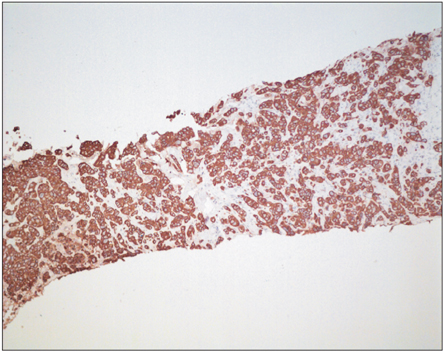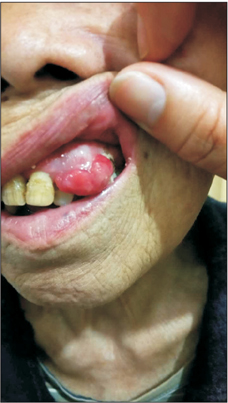Ann Surg Treat Res.
2017 Nov;93(5):277-280. 10.4174/astr.2017.93.5.277.
Cutaneous metastasis: a rare phenomenon of colorectal cancer
- Affiliations
-
- 1Division of Colorectal Surgery, Department of Surgery, The First Affiliated Hospital, College of Medicine, Zhejiang University, Hangzhou, China.
- 2Division of Hepatobiliary and Pancreatic Surgery, Department of Surgery, The First Affiliated Hospital, College of Medicine, Zhejiang University, Hangzhou, China. zjxu@zju.edu.cn
- KMID: 2393994
- DOI: http://doi.org/10.4174/astr.2017.93.5.277
Abstract
- Cutaneous metastases from colorectal cancer are extremely rare and generally appear several years after diagnosis or resection of the primary tumor. Although this phenomenon is uncommon, it is very important and often indicates a poor prognosis. We present a case of a 76-year-old female patient with multiple cutaneous metastatic nodules on the back, just 1 month after resection of rectal cancer. Unfortunately, the patient gave up the follow-up treatment due to her age and poor physical condition; she died 3 months later. In view of its rarity of occurrence and lack of experience in treatment, we reviewed the literature and report as follows.
Keyword
MeSH Terms
Figure
Reference
-
1. Lookingbill DP, Spangler N, Helm KF. Cutaneous metastases in patients with metastatic carcinoma: a retrospective study of 4020 patients. J Am Acad Dermatol. 1993; 29(2 Pt 1):228–236.2. Hashimi Y, Dholakia S. Facial cutaneous metastasis of colorectal adenocarcinoma. BMJ Case Rep. 2013; 2013. pii: bcr2013009875. DOI: 10.1136/bcr-2013-009875.3. Cidon EU. Cutaneous metastases in 42 patients with cancer. Indian J Dermatol Venereol Leprol. 2010; 76:409–412.4. Aravind B, Kumar R, Basnyat P. Cutaneous metastases secondary to colorectal carcinoma may not be as ominous as previously thought: a case report and review of the literature. BMJ Case Rep. 2013; 2013. pii: bcr2013008556. DOI: 10.1136/bcr-2013-008556.5. Wong CY, Helm MA, Kalb RE, Helm TN, Zeitouni NC. The presentation, pathology, and current management strategies of cutaneous metastasis. N Am J Med Sci. 2013; 5:499–504.6. Nesseris I, Tsamakis C, Gregoriou S, Ditsos I, Christofidou E, Rigopoulos D. Cutaneous metastasis of colon adenocarcinoma: case report and review of the literature. An Bras Dermatol. 2013; 88:6 Suppl 1. 56–58.7. Schoenlaub P, Sarraux A, Grosshans E, Heid E, Cribier B. Survival after cutaneous metastasis: a study of 200 cases. Ann Dermatol Venereol. 2001; 128:1310–1315.8. Oh SY, Kim DY, Suh KW. Oncologic outcomes following metastasectomy in colorectal cancer patients developing distant metastases after initial treatment. Ann Surg Treat Res. 2015; 88:253–259.9. Leong SP, Gershenwald JE, Soong SJ, Schadendorf D, Tarhini AA, Agarwala S, et al. Cutaneous melanoma: a model to study cancer metastasis. J Surg Oncol. 2011; 103:538–549.10. Flaherty KT, Puzanov I, Kim KB, Ribas A, McArthur GA, Sosman JA, et al. Inhibition of mutated, activated BRAF in metastatic melanoma. N Engl J Med. 2010; 363:809–819.
- Full Text Links
- Actions
-
Cited
- CITED
-
- Close
- Share
- Similar articles
-
- A Case of Esophageal Adenocarcinoma Metastasized to the Scalp
- Zosteriform Cutaneous Metastasis from a Gastric Adenocarcinoma
- Endotracheal Metastasis Seen on FDG PET/CT in a Patient with Previous Colorectal Cancer
- Clinical Characteristics of Ovarian Metastasis from Colorectal Cancer
- Expression of Tumor Metastasis Related Genes in Korean Colorectal Cancers and Cell lines





